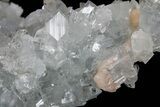This Specimen has been sold.
6.5" Apophyllite and Stilbite on Quartz Chalcedony Stalactites - India
This is a breathtaking, 6.5" wide by 5.6" tall mineral association containing lustrous, double-terminated apophyllite crystals, peach colored stilbite crystals and quartz/chalcedony. The quartz chalcedony formed as stalactites along the ceiling of a cavity, with apophyllite and stilbite crystals that formed over the quartz stalactite. This gorgeous specimen was collected from Maharashtra, India.
About Apophyllite & Stilbite From India
This specimen originates from the Deccan Traps near Pune in western India—one of the world’s largest igneous provinces and an immense volcanic formation created by ancient lava flows. During quarrying or well-digging, miners occasionally break into hidden cavities within the basalt, revealing spectacular pockets lined with zeolite minerals and associated species.
Stilbite is the most commonly encountered zeolite in these deposits, typically forming graceful bowtie, flower-like, or hourglass crystal clusters in a range of colors. The most sought-after examples display soft pink to peach hues. Closely associated with the zeolites is apophyllite, which commonly occurs in the same mineral pockets. Though not a zeolite itself, apophyllite forms striking crystals as either elongated prisms topped with sharp pyramids or near-cubic shapes. While relatively unknown outside mineral circles, both minerals are highly prized by collectors for their delicate pastel colors and elegant crystal habits.
This specimen originates from the Deccan Traps near Pune in western India—one of the world’s largest igneous provinces and an immense volcanic formation created by ancient lava flows. During quarrying or well-digging, miners occasionally break into hidden cavities within the basalt, revealing spectacular pockets lined with zeolite minerals and associated species.
Stilbite is the most commonly encountered zeolite in these deposits, typically forming graceful bowtie, flower-like, or hourglass crystal clusters in a range of colors. The most sought-after examples display soft pink to peach hues. Closely associated with the zeolites is apophyllite, which commonly occurs in the same mineral pockets. Though not a zeolite itself, apophyllite forms striking crystals as either elongated prisms topped with sharp pyramids or near-cubic shapes. While relatively unknown outside mineral circles, both minerals are highly prized by collectors for their delicate pastel colors and elegant crystal habits.
About Quartz
Quartz is the name given to silicon dioxide (SiO2) and is the second most abundant mineral in the Earth's crust. Quartz crystals generally grow in silica-rich environments--usually igneous rocks or hydrothermal environments like geothermal waters--at temperatures between 100°C and 450°C, and usually under very high pressure. In either case, crystals will precipitate as temperatures cool, just as ice gradually forms when water freezes. Quartz veins are formed when open fissures are filled with hot water during the closing stages of mountain formation: these veins can be hundreds of millions of years old.
Quartz is the name given to silicon dioxide (SiO2) and is the second most abundant mineral in the Earth's crust. Quartz crystals generally grow in silica-rich environments--usually igneous rocks or hydrothermal environments like geothermal waters--at temperatures between 100°C and 450°C, and usually under very high pressure. In either case, crystals will precipitate as temperatures cool, just as ice gradually forms when water freezes. Quartz veins are formed when open fissures are filled with hot water during the closing stages of mountain formation: these veins can be hundreds of millions of years old.
Chalcedony is any microcrystalline variety of silica composed of very fine intergrowths of quartz and mogánite: microcrystalline minerals have microscopic crystals that cannot be observed by the naked eye. Both quartz and mogánite have the same chemical formula SiO2 (silicon dioxide), but different crystal structures. When free from impurities, chalcedony is colorless and transparent. Depending on impurities present during formation, chalcedony can form in a wide variety of colors including red, yellow, green, blue, purple, grey, white, and numerous hues in between. Chalcedony is quite hard at 7 on the Mohs Hardness Scale: this matches its main component quartz, which is the benchmark mineral for the scale at 7.
SPECIES
Apophyllite, Stilbite, Quartz & Quartz var. Chalcedony
LOCATION
Maharashtra, India
SIZE
6.5" wide, 5.6" tall
CATEGORY
ITEM
#176838
 Reviews
Reviews

















